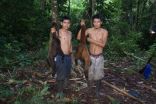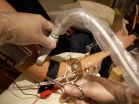(Press-News.org) The spread of diseases from land animals to sea otters and other marine mammals is aided and abetted by gelatinous, sticky polymers produced by seaweed, reports a research team headed by a UC Davis veterinary infectious-disease expert.
These large, complex molecules form slimy biofilms and bind water-borne organic matter into larger particles, in which disease-causing microorganisms can become embedded and introduced to the marine food chain, the researchers discovered.
Using the parasite Toxoplasma gondii as a model, they showed how these sticky polymers increase the chance that disease-causing organisms would be picked up by marine snails, which graze on kelp and are among the common foods of some endangered sea otters.
Findings from the new study will be published Oct. 8 in the journal Proceedings of the Royal Society B.
"Discovering the role that these invisible polymers play in disease transmission in the ocean is a tremendous step forward in helping us better understand and mitigate the impacts of coastal water pollution on the health of wildlife and humans," said lead author Karen Shapiro, a research scientist in the School of Veterinary Medicine.
Sea otters and humans at risk
Contamination of coastal waters with disease-causing microorganisms is known to pose a threat to the health of both humans and animals, but the mechanisms by which diseases are transmitted in marine ecosystems has until now remained a mystery.
The researchers focused on Toxoplasma gondii, a protozoan parasite that infects animals and humans worldwide.
The parasite actively reproduces in various cat species including domestic cats. Its egg cells pass on in cat feces and can persist in the environment for months to years, infecting marine mammals including the endangered southern sea otter in California.
Humans also can be infected by T. gondii when they consume contaminated water or undercooked shellfish.
Snails to sea otter transmission
Puzzled by the high rate of T. gondii infection in sea otters and other marine mammals, the researchers set out to track the route of transmission. Noting that T. gondii infections were 10 times more common among sea otters that fed heavily on kelp-grazing marine snails than among otters that fed on abalone and other ocean food sources, they investigated why the sea snails might be particularly effective carriers of the parasite.
In laboratory tests, the researchers discovered that the gelatinous polymers, excreted by seaweed, act in two ways to provide an environment conducive to transmission of infectious diseases. First, the polymers act like glue, binding together water-borne organic material into larger particles, in which infectious agents like the T. gondii egg cells can embed and more quickly settle to the ocean floor.
Secondly, the polymers help to form sticky biofilms, which can trap the T. gondii egg cells and coat kelp on which marine snails graze. The parasite then can be easily passed on when the snails are eaten by otters, completing the intricate chain of disease transmission from land-based cats to the endangered coastal sea otters.
INFORMATION:
Other researchers on the study were Colin Krusor, Patricia A. Conrad, John L. Largier and Jonna A.K. Mazet, all of UC Davis, and Fernanda F.M. Mazzillo and Mary W. Silver, both of UC Santa Cruz.
The National Science Foundation's Evolution and Ecology of Infectious Disease program provided funding for the study.
About UC Davis
UC Davis is a global community of individuals united to better humanity and our natural world while seeking solutions to some of our most pressing challenges. Located near the California state capital, UC Davis has more than 34,000 students, and the full-time equivalent of 4,100 faculty and other academics and 17,400 staff. The campus has an annual research budget of over $750 million, a comprehensive health system and about two dozen specialized research centers. The university offers interdisciplinary graduate study and 99 undergraduate majors in four colleges and six professional schools.
Media contacts:
-- Karen Shapiro, School of Veterinary Medicine, (530) 219-5476, kshapiro@ucdavis.edu
-- Pat Bailey, UC Davis News Service, (530) 752-9843, pjbailey@ucdavis.edu
Rochester, MN, October 7, 2014 – Numerous randomized clinical trials have shown the effectiveness of the two major forms of smoking cessation treatment – behavioral support and medication - in helping smokers quit. Researchers have now demonstrated that this approach can successfully translate to the "real world" and that a combination of the two treatments offers almost a threefold chance of success over attempts to quit without using a cessation aid. Their findings are published in Mayo Clinic Proceedings.
"Randomized clinical trials have a high internal ...
There is evidence that hunter-gatherers are optimal foragers whose behaviour is influenced by costs associated with foraging, and therefore for example rising the costs of ammunition could potentially help conserving wild animals. However, there has been a paucity of studies on whether the behaviour of bushmeat hunters, like that of consumers, is cost sensitive moneywise.
In Ecuador, ammunition prices rose unexpectedly by 300 per cent in early 2009, because of a tax imposed by the national Government. This happened right when Anders Sirén, then postdoc researcher ...
Adolescence is often a turbulent time, and it is marked by substantially increased rates of depressive symptoms, especially among girls. New research indicates that this gender difference may be the result of girls' greater exposure to stressful interpersonal events, making them more likely to ruminate, and contributing to their risk of depression.
The findings are published in Clinical Psychological Science, a journal of the Association for Psychological Science.
"These findings draw our focus to the important role of stress as a potential causal factor in the development ...
The human and environmental dangers posed by a widely used manufacturing technique could be almost eradicated thanks to research led by Plymouth University.
Fibre-reinforced polymer matrix composites are painted or sprayed onto products to provide a high-quality finish in transport applications, chemical plants, renewable energy systems and pipelines.
But that finishing process causes the vapours of a volatile organic compound – styrene, found in polyesters and vinyl-esters – to be emitted, posing potential health and wellbeing risks to the workforces involved ...
Scientists from the University of Leeds have taken a crucial step forward in bio-nanotechnology, a field that uses biology to develop new tools for science, technology and medicine.
The new study, published in print today in the journal Nano Letters, demonstrates how stable 'lipid membranes' – the thin 'skin' that surrounds all biological cells – can be applied to synthetic surfaces.
Importantly, the new technique can use these lipid membranes to 'draw' – akin to using them like a biological ink – with a resolution of 6 nanometres (6 billionths ...
VIDEO:
The Arctic and the Antarctic are regions that have a lot of ice and acts as air conditioners for the Earth system. This year, Antarctic sea ice reached a record...
Click here for more information.
Sea ice surrounding Antarctica reached a new record high extent this year, covering more of the southern oceans than it has since scientists began a long-term satellite record to map sea ice extent in the late 1970s. The upward trend in the Antarctic, however, is only about ...
Stretch sensors in our muscles participate in reflexes that serve the subconscious control of posture and movement. According to a new study published in the Journal of Neuroscience, these sensors respond weakly to muscle stretch caused by one's voluntary action, and most strongly to stretch that is imposed by external forces. The ability to reflect causality in this manner can facilitate appropriate reflex control and accurate self-perception.
"The results of the study show that stretch receptors in our muscles indicate more than which limb is moving or how fast; these ...
Just like adjusting a watch, the key to accurately telling evolutionary time is based upon periodically calibrating against a gold standard.
Scientists have long used DNA data to develop molecular clocks that measure the rate at which DNA changes, i.e., accumulates mutations, as a premiere tool to peer into the past evolutionary timelines for the lineage of a given species. In human evolution, for example, molecular clocks, when combined with fossil evidence, have helped trace the time of the last common ancestor of chimpanzees and humans to 5-7 million years ago, and ...
During cell division, chromosomes acquire a characteristic X-shape with the two DNA molecules (sister chromatids) linked at a central "connection region" that contains highly compacted DNA. It was unknown if rearrangements in this typical X-shape architecture could disrupt the correct separation of chromosomes. A recent study by Raquel Oliveira, from the Instituto Gulbenkian de Ciência (Portugal), in collaboration with colleagues from the University of California, Santa Cruz (USA), now shows that the dislocation of particular DNA segments perturbs proper chromosome ...
One key to animal survival is bitter taste----the better to avoid ingesting potentially harmful poisons or foods. The evolution of bitter taste has been a hot topic amongst evolutionary biologists, and with more and more DNA data available, a rich area of exploration.
Now, professor Maik Behrens, et. al. examined the genetic repertoire of bitter taste receptor genes in chickens and frogs, which represent two extremes. Chickens only have 3 bitter taste receptor genes (Tas2rs), while frogs have more than 50 (humans are somewhere in the middle). They studied the different ...



